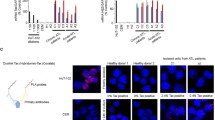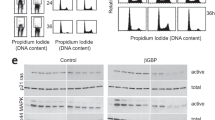Abstract
Human T-cells immortalized (interleukin-2 [IL-2] dependent) by the human T-cell lymphotropic/leukemia virus type I (HTLV-I), in time, become transformed (IL-2 independent). To understand the biochemical basis of this transition, we have used the sibling HTLV-I-infected T-cell lines, N1186 (IL-2 dependent) and N1186-94 (IL-2 independent), as models to assess the responses to antiproliferative signals. In N1186 cells arrested in G1 after serum/interleukin-2 (IL-2) deprivation, downregulation of the cyclin E-CDK2 kinase activity correlated with decreased phosphorylation of CDK2 and accumulation of p27Kip1 bound to the cyclin E-CDK2 complex, as seen in normal activated PBMCs (peripheral blood mononuclear cells). In contrast, N1186-94 cells failed to arrest in G1 upon serum starvation, displayed constitutive cyclin E-associated kinase activity, and, although CDK2 was partially dephosphorylated, the amount of p27Kip1 bound to the complex did not increase. This observation, extended to two other IL-2-dependent as well as to three IL-2-independent HTLV-I-infected T-cell lines, suggests that the lack of cyclin E-CDK2 kinase downregulation found in the late phase of HTLV-I transformation may correlate with insufficient amounts of p27Kip1 associated with the cyclin E-CDK2 complex. Reconstitution experiments demonstrated that the addition of p27Kip1 to lysates from N1186-94 starved cells resulted in the downregulation of cyclin E-associated kinase activity supporting the notion that the unresponsiveness of the cyclin E-CDK2 complex to growth inhibitory signals may be due to inadequate amounts of p27Kip1 assembled with the complex in HTLV-I-transformed T-cells. In fact, the amount of p27Kip1 protein was lower in most HTLV-I-transformed (IL-2-independent) than in the immortalized (IL-2-dependent) HTLV-I-infected T-cells. Furthermore, specific inhibitors of the phosphatidylinositol 3-kinase (PI3K) induced an increase of p27Kip1 protein levels, which correlated with G1 arrest, in both IL-2-dependent and IL-2-independent HTLV-I-infected T-cells. Altogether, these results suggest that maintaining a low level of expression of p27Kip1 is a key event in HTLV-I transformation.
This is a preview of subscription content, access via your institution
Access options
Subscribe to this journal
Receive 50 print issues and online access
$259.00 per year
only $5.18 per issue
Buy this article
- Purchase on Springer Link
- Instant access to full article PDF
Prices may be subject to local taxes which are calculated during checkout







Similar content being viewed by others
References
Akagi T, Ono H and Shimotohno K. . 1996 Oncogene 12: 1645–1652.
Brennan P, Babbage JW, Burgering BMT, Groner B, Reif K and Cantrell DA. . 1997 Immunity 7: 679–689.
Cereseto A, Berneman Z, Koralnik I, Vaughn J, Franchini G and Klotman ME. . 1997 Leukemia 11: 866–870.
Cereseto A, Diella F, Mulloy JC, Cara A, Michieli P, Grassman R, Franchini G and Klotman ME. . 1996 Blood 88: 1551–1560.
Coats S, Flanagan WM, Nourse J and Roberts JM. . 1996 Science 272: 877–880.
Dumont FJ and Su Q. . 1995 Life Sci. 58: 373–395.
EI Deiry WS, Tokino T, Velculescu VE, Levy DB, Parsons R, Trent JM, Lin D, Mercer WE, Kinzler KW and Vogelstein B. . 1993 Cell 75: 817–825.
Fero ML, Rivkin M, Tasch M, Porter P, Carow CE, Firpo E, Polyak K, Tsai L-H, Broudy V, Perlmutter RM, Kaushansky K and Roberts JM. . 1996 Cell 85: 733–744.
Firpo EJ, Koff A, Solomon MJ and Roberts JM. . 1994 Mol. Cell. Biol. 14: 4889–4901.
Franchini G. . 1995 Blood 86: 3619–3639.
Gong J, Ardelt B, Traganos F and Darzynkiewicz Z. . 1994 Cancer Res. 54: 4285–4288.
Gu Y, Rosenblatt J and Morgan DO. . 1992 EMBO J. 11: 3995–4005.
Harper JW, Adami GR, Wei N, Keyomarsi K and Elledge SJ. . 1993 Cell 75: 805–816.
Johnson D, Frame MC and Wyke JA. . 1998 Oncogene 16: 2017–2028.
Keyomarsi K and Pardee AB. . 1993 Proc. Natl. Acad. Sci. USA 90: 1112–1116.
Keyomarsi K, O'Leary N, Molnar G, Lees E, Fingert HL and Pardee AB. . 1994 Cancer Res. 54: 380–385.
Kiyokawa H, Kineman RD, Manova-Todorova KO, Soares VC, Hoffman ES, Ono M, Khanam D, Hayday AC, Frohman LA and Koff A. . 1996 Cell 85: 721–732.
Koff A, Giordano A, Desai D, Yamashita K, Harper JW, Elledge S, Nashimoto T, Morgan DO, Franza BR and Roberts JM. . 1992 Science 257: 1959–1964.
Koff A, Ohtsuki M, Polyak K, Roberts JM and Massague J. . 1993 Science 260: 536–539.
La Baer J, Garret MD, Stevenson LF, Slingerland JM, Sandhu C, Chou HS, Fattaey A and Harlow E. . 1997 Genes Dev. 11: 847–862.
Leach FS, Elledge SJ, Sherr CJ, Willson JKV, Markowitz S, Kinzler KW and Vogelstein B. . 1993 Cancer Res. 53: 1986–1989.
Liu Y, Martindale JL, Gorospe M and Holbrook NJ. . 1996 Cancer Res. 56: 31–35.
Macleod KF, Sherry N, Hannon G, Beach D, Tokino T, Kinzler K, Vogelstein B and Jacks T. . 1995 Genes Dev. 9: 935–944.
Mantel C, Luo Z, Canfield J, Braun S, Deng C and Broxmeyer HE. . 1996 Blood 88: 3710–3719.
Markham PD, Salahuddin SZ, Kalyanaraman VS, Popovic M, Sarin P and Gallo RC. . 1983 Int. J. Cancer 31: 413–420.
Migone T-S, Lin JX, Cereseto A, Mulloy JC, O'Shea JJ, Franchini G and Leonard WJ. . 1995 Science 269: 79–81.
Migone T-S, Cacalano NA, Taylor N, Yi T, Waldmann TA and Johnston JA. . 1998 Proc. Natl. Acad. Sci. USA 95: 3845–3850.
Miyoshi I, Kubonishi I, Yoshimoto S, Akagi T, Ohtsuki Y, Shiraishi Y, Nagata K and Hinuma Y. . 1981 Nature 294: 770–771.
Morgan DO. . 1995 Nature 374: 131–134.
Mulloy JC, Migone T-S, Ross TM, Ton N, Green PL, Leonard WJ and Franchini G. . 1998 J. Virol. 72: 4408–4412.
Nakayama K, Ishida N, Shirane M, Inomata A, Inoue T, Shishido N, Horii I, Loh DY and Nakayama K-I. . 1996 Cell 85: 707–720.
Nourse J, Firpo E, Flanagan WM, Coats S, Polyak K, Lee M-H, Massague J, Crabtree GR and Roberts JM. . 1994 Nature 372: 570–573.
Pagano M, Tam SW, Theodoras AM, Beer-Romero P, Del Sal G, Chau V, Yew PR, Draetta GF and Rolfe M. . 1995 Science 269: 682–685.
Polyak K, Lee M-H, Erdjument-Bromage H, Koff A, Roberts JM, Tempst P and Massague' J. . 1994 Cell 78: 59–66.
Popovic M, Lange-Wantzin G, Sarin PS, Mann D and Gallo RC. . 1983 Proc. Natl. Acad. Sci. USA 80: 5402–5406.
Sheaff RJ, Groudine M, Gordon M, Roberts JM and Clurman BE. . 1997 Genes Dev. 11: 1464–1478.
Takemoto S, Mulloy JC, Cereseto A, Migone T-S, Patel BKR, Matsuoka M, Yamaguchi K, Takatsuki K, Kamihira S, White JD, Leonard W, Waldmann T and Franchini G. . 1997 Proc. Natl. Acad. Sci. USA 94: 13897–13902.
Toyoshima H and Hunter T. . 1994 Cell 78: 67–74.
Vlach J, Hennecke S and Amati B. . 1997 EMBO J. 16: 5334–5344.
Xu X, Kang SH, Heidenreich O, Okerholm M, O'Shea JJ and Nerenberg MI. . 1995 J. Clin. Invest. 96: 1548–1555.
Zetterberg A, Larsson O and Wiman KG. . 1995 Curr. Opin. Cell. Biol. 7: 835–842.
Zhang H, Hannon J and Beach D. . 1994 Genes Dev. 8: 1750–1758.
Acknowledgements
We thank Drs A Cara and JC Mulloy for helpful discussion and Kelli Carrington, Steven Snodgrass, and Sydnye White for editorial assistance.
Author information
Authors and Affiliations
Rights and permissions
About this article
Cite this article
Cereseto, A., Parks, R., Rivadeneira, E. et al. Limiting amounts of p27Kip1 correlates with constitutive activation of cyclin E-CDK2 complex in HTLV-I-transformed T-cells. Oncogene 18, 2441–2450 (1999). https://doi.org/10.1038/sj.onc.1202567
Received:
Revised:
Accepted:
Published:
Issue Date:
DOI: https://doi.org/10.1038/sj.onc.1202567
Keywords
This article is cited by
-
Cyclin-dependent kinases and CDK inhibitors in virus-associated cancers
Infectious Agents and Cancer (2020)
-
KSHV vCyclin counters the senescence/G1 arrest response triggered by NF-κB hyperactivation
Oncogene (2015)
-
HTLV-I p30 inhibits multiple S phase entry checkpoints, decreases cyclin E-CDK2 interactions and delays cell cycle progression
Molecular Cancer (2010)
-
HTLV-1 Tax mutants that do not induce G1arrest are disabled in activating the anaphase promoting complex
Retrovirology (2007)
-
Activation of the anaphase promoting complex by HTLV-1 tax leads to senescence
The EMBO Journal (2006)



